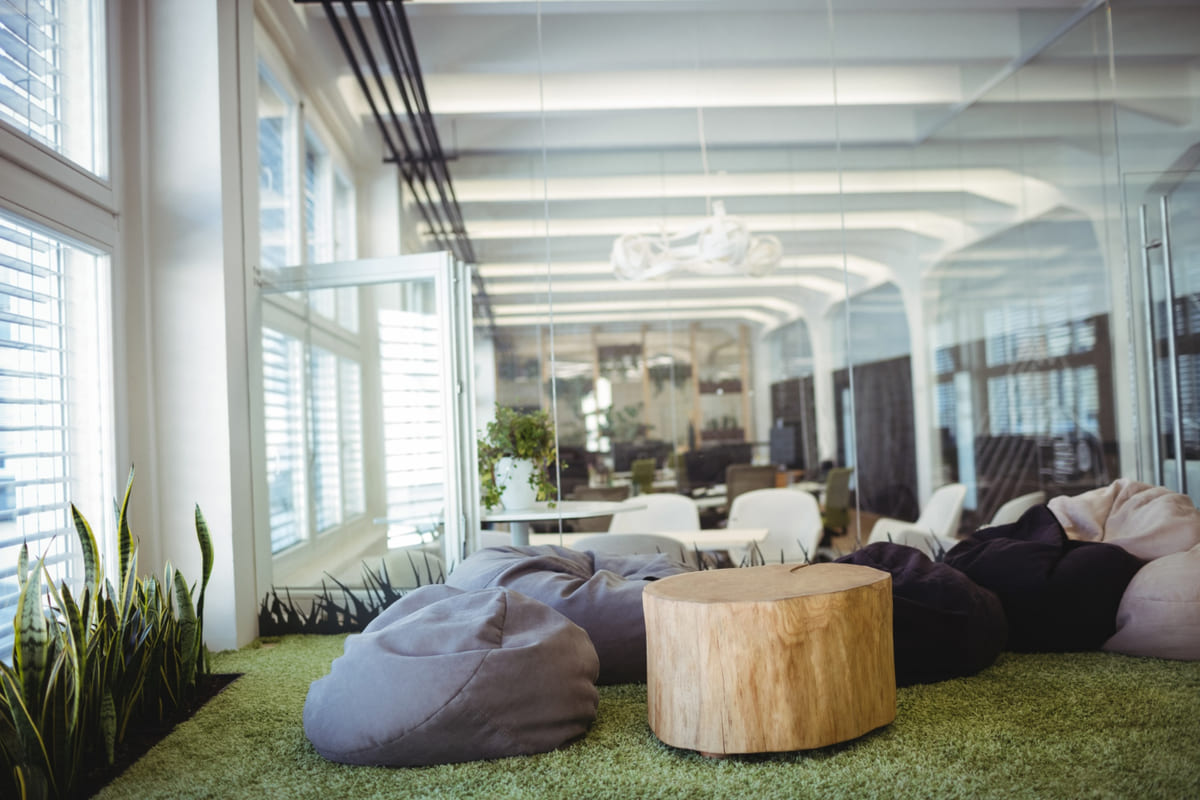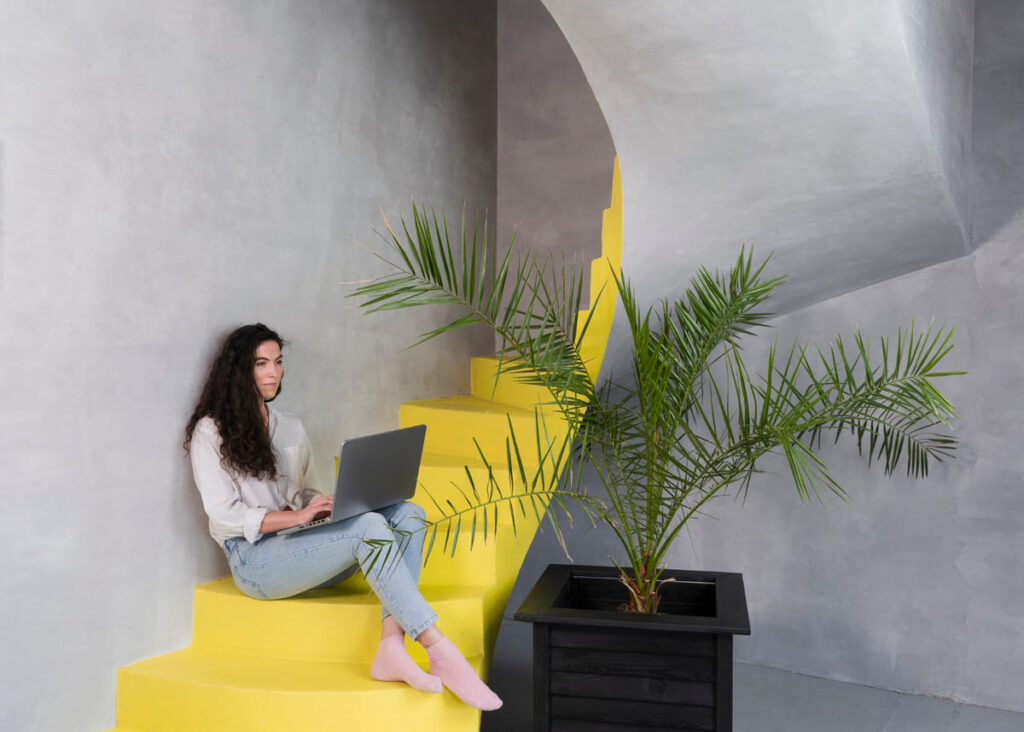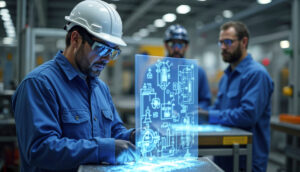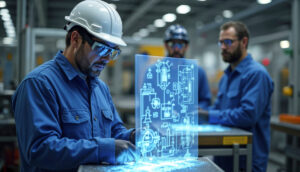Biophilic design embraces natural elements and processes in built environments. It is rooted in biophilia, the inherent human affinity for nature. In practice, biophilic offices use features like abundant daylight, plant life, water elements and natural materials to create a sense of the outdoors indoors. This approach is gaining traction across industries as companies seek healthier, future-ready workplaces. Connecting people with nature at work has been linked to better health, more satisfaction and stronger staff engagement than sterile environments. As designers and decision-makers reimagine offices for the 21st century, biophilic design is seen as a key strategy for promoting wellness and performance on a broad scale.
Table of Contents
Benefits of Biophilic Design in the Workplace
1. Enhanced Employee Well-being
Numerous studies show that adding natural elements improves physical and mental health. Exposure to greenery and daylight is associated with lower stress and fatigue, reduced symptoms of sick building syndrome, and even faster healing of ailments. For example, research finds that nature exposure yields stress reduction and better emotional well-being, as well as improvements in concentration and social interaction. In one biophilic office retrofit study, early results indicated “strong positive effects” on worker well-being – employees reported feeling healthier, more comfortable and more satisfied in a plant-rich, naturally lit space. In practice, biophilic workplaces report higher job satisfaction and lower turnover – employees simply feel happier and healthier in environments that mimic nature.
2. Improved Productivity and Cognitive Performance
By leveraging attention-restoration effects of nature, biophilic design can boost focus and creativity. Views of plants or sky, natural light and organic materials help replenish mental energy and reduce fatigue. For instance, a workplace with ample daylight and views of vegetation can improve concentration and cognitive function. In a controlled study, office workers with windows had significantly better vitality and fewer sleep disturbances than those in windowless spaces.
This translates into better job performance: employees in nature-infused offices often work more efficiently and make fewer errors. A field experiment of biophilic offices found increases in perceived productivity, faster task completion and even boosts in creativity when greenery and daylight were added. Overall, integrating nature is shown to “boost productivity… and enhance…collaboration” in teams.
3. Reduced Stress and Absenteeism
Contact with nature is a proven stress-reliever. Biophilic workspaces typically see lower stress levels and better physiological health among staff. For example, studies report that simply having indoor plants or garden views can reduce heart rate and blood pressure, indicating calmer, less stressed workers. Stress reduction leads to tangible business benefits: less burnout, fewer sick days and higher attendance. In the site office study, biophilic interventions “ameliorated stress” and improved overall health. Similarly, offices with good daylight and ventilation report far fewer reports of illness and absenteeism than poorly designed ones. In practice this means companies with biophilic design often see lower turnover and healthcare costs as employees stay healthier and engaged.
4. Positive Organizational Culture
When employees share an uplifting, nature-rich environment, workplace culture tends to improve. Biophilic design fosters collaboration, creativity and a sense of belonging. The aforementioned study observed that plants and light “foster[ed] a collaborative work environment” and raised overall workplace satisfaction. In essence, bringing the outside in creates more inviting communal spaces (such as lobbies, lounges or cafeterias) where people naturally gather and interact. Employees also take pride in working for organizations that prioritize their health; this contributes to a positive employer brand and team morale. Over time, a biophilic office can help build an atmosphere of well-being, innovation and mutual support – all essential elements of a strong, future-ready corporate culture.
Suggested article to read: What is Biophilic Architecture? 2024 Guide

Key Biophilic Design Strategies for Different Workplace Types
1. General Offices
General office buildings can adopt broad biophilic strategies that apply across many industries:
-
Incorporating Natural Light: Maximize daylight through windows, skylights and open layouts. Designs should position workstations and meeting areas near windows or rooflights. In one study, employees in windowed offices scored higher on vitality and sleep quality tests than those in windowless spaces. Proper daylighting supports circadian rhythms, improves mood and reduces reliance on artificial lighting. Light shelves, clerestories or light wells can draw sun deeper into the floorplate.
-
Using Living Walls and Indoor Plants: Vertical green walls and potted plants help clean the air and break visual monotony. A dense living wall can make a dramatic focal point in a lobby or atrium, while smaller planters on desks or in common areas add biophilic accents. For example, a project office retrofit included “significant plants” throughout the workspace. Studies of such spaces have found lower reported stress and higher concentration. Even a single desk plant can boost satisfaction and air quality. (Designers should ensure plant health with proper lighting and care.)
-
Access to Outdoor Spaces: Encourage breaks outdoors by providing easy routes to courtyards, terraces, green rooftops or gardens. An outdoor patio or landscaped roof with seating invites people outside for fresh air. This direct access is linked to quick mental recovery: brief outdoor breaks in greenery reduce fatigue and stress. For instance, a garden or patio adjoining an office can serve as a restorative retreat at lunchtime or during creative sessions. By blurring indoor/outdoor boundaries with patios and operable walls, workers get the benefits of nature without leaving the campus.
2. Tech Industry Workplaces
High-tech companies often lead in biophilic innovation. Their campuses and offices commonly employ the following:
-
Nature-Inspired Open Plans: Tech campuses favor open, flexible layouts that echo natural forms. Curvilinear partitions, atriums and irregular floorplans mimic organic landscapes. For example, Amazon’s “Spheres” (three glass domes in Seattle) create an indoor rain-forest setting for collaboration. Google and Apple have similarly incorporated natural motifs and flowing interiors. These designs draw on biophilic principles to encourage exploration and teamwork. An open plan with natural materials and light gives a sense of continuity with nature, supporting the company’s culture of innovation and transparency.
-
Sensory Integration (Sound, Scent, Textures): Beyond visuals, tech workplaces integrate natural sounds and textures. Features like indoor water fountains or ambient forest sounds can mask noise and provide calming background. Natural materials—wood floors, stone cladding, wool textiles—give tactile warmth. Some offices even use subtle nature-based scents (e.g. pine or citrus) to create a fresh atmosphere. For instance, using real wood in furniture and warm stone finishes in meeting rooms can make high-tech settings feel more grounded. These multi-sensory touches ensure that the biophilic experience is immersive, not just visual.

3. Healthcare Industry Workplaces
Hospitals and clinics have long recognized the healing power of nature. Biophilic strategies here focus on patient and staff wellness:
-
Healing Gardens and Green Retreats: Dedicated gardens for patients, families and staff are key in healthcare design. These might be rooftop gardens, courtyard parks or ground-level green spaces. Studies of healing gardens show they reduce patient anxiety and even shorten recovery times. For example, the Khoo Teck Puat Hospital in Singapore uses extensive landscaping so that patients see greenery from their rooms. Nurses and doctors also benefit: a break in a quiet garden lowers stress and restores attention. For workplaces in healthcare, simple courtyards with comfortable seating, shade and plantings act as recharge zones. Graphic murals of nature or natural light tubes in treatment areas serve a similar restorative role.
-
Daylight and Circadian Lighting: In hospitals, aligning light with natural rhythms is crucial. Wherever possible, patient rooms and staff areas should have large windows and daylight views. Many modern healthcare buildings employ dynamic lighting systems that change color temperature throughout the day to mimic sunrise and sunset. Adequate daylight and circadian-aligned lighting help patients sleep better and improve staff alertness on long shifts. (One study found that office workers with access to daylight reported better sleep quality than those in windowless offices, suggesting similar gains in hospital settings.) Good daylighting also supports mood and immune function – both vital for healing environments.
4. Financial Industry Workplaces
Corporate banks and finance firms often balance high-contrast environments with biophilic touches:
-
Natural Materials and Finishes: Financial workplaces frequently use rich woods, polished stone and earth-toned finishes to add warmth. For instance, oak paneling in a trading floor or marble and wood in a banking hall bring subtle nature cues. Textured natural finishes (like cork bulletin boards or stone-textured wall coverings) can replace sterile plastics. These materials ground employees in a more human-scale aesthetic. Studies have found that interiors using real wood and stone evoke calmness and lower perceived stress among occupants. Thus, even in a glass-and-steel office tower, introducing these elements can soften the vibe and improve comfort.
-
Calm Zones and Breakout Spaces: High-pressure finance settings benefit from quiet “green” retreats. Designated break rooms or lounges with plants, soft seating and views of greenery provide sanctuary. For example, a bank might create a zen-inspired breakout area with indoor plants, water features (like a wall fountain) and gentle light. Even small “focus pods” lined with wood and plant views can help traders or analysts reset. By strategically placing these calm zones near clusters of desks, employers encourage employees to take restorative micro-breaks. Such spaces send the message that well-being matters, improving morale and focus throughout the office.

Real-World Case Studies
Around the world, leading companies and institutions showcase biophilic design in action. For example, Amazon’s Spheres in Seattle are three glass-dome conservatories filled with thousands of plants – an indoor botanical garden where employees meet and work. This project literally envelops workers in a natural environment, illustrating how bold biophilic concepts can inspire creativity. In the tech sector, companies like Google and Microsoft have commissioned campus buildings with green rooftops and open-air spaces (e.g. Google’s NYC office includes a landscaped terrace).
Healthcare institutions also feature famous examples: Singapore’s Khoo Teck Puat Hospital uses extensive greenery – from rooftop farms to interior gardens – to create a campus that feels more park than hospital. These green areas support faster patient healing and happier staff. In finance, some global banks have retrofit projects incorporating plant walls and daylighting: for instance, a major Hong Kong trading floor installed living walls and a central atrium garden to reduce employee stress.
Other notable cases include biophilic classrooms and government offices. For example, a Stockholm school used forest-themed furniture and skylights so children spend more time connected to nature. Overall, these examples demonstrate that weaving nature into buildings – whether a corporation’s HQ or a community health center – yields measurable well-being and productivity gains.
FAQs
How does Biophilic Design in the Workplace boost employee well-being?
Biophilic design enhances well-being by reintroducing nature’s benefits indoors. Natural light, green views and plant life reduce stress hormones and improve mood. These elements help employees feel calmer and more refreshed. Studies show workers in nature-rich offices report better health and comfort. For example, a biophilic office retrofit led to significantly higher employee satisfaction and reduced fatigue levels. In practice, staff enjoy lower anxiety and improved overall wellness in biophilic environments, which translates into a happier workforce.
What are examples of Biophilic Design elements in modern offices?
Common biophilic strategies include large windows for daylight, living green walls or plantscapes, and views or access to outdoors. Designers may use natural materials (wood, stone), curving architecture, and indoor water features to mimic natural settings. For instance, an office might have a plant-filled atrium, nature-themed wall art, and a patio garden. These elements work together to bring the outdoors in. A case study site office even used open-plan layouts, abundant plants and natural ventilation as biophilic features. Such designs provide regular sensory interactions with nature, which rejuvenate employees throughout the day.
Which industries benefit most from Biophilic Design in the Workplace?
While all industries gain from biophilia, some sectors leverage it uniquely. Tech companies use biophilic design to foster creativity – e.g., Google and Amazon have green campus spaces and nature-inspired offices. Healthcare settings use gardens and natural light to aid patient recovery and staff well-being. Finance and corporate offices adopt natural materials and quiet plant-filled lounges to reduce stress in high-pressure jobs. General offices of any type also benefit from daylight and plants. In each case, the goal is the same: using biophilic design tailored to the industry’s needs (like healing gardens in hospitals or open parks in tech campuses) helps employees perform better and feel healthier.
Is it true that Biophilic Design in the Workplace can reduce stress and absenteeism?
Yes. Research shows workplaces with natural elements see significantly lower stress and fewer sick days. Natural light and plants help regulate physiological stress responses and reduce symptoms like headaches or eye strain. For example, office workers with window access reported better sleep and vitality than those without windows. In one study, adding biophilic features “ameliorated stress” and led to fewer health complaints. When stress levels drop, employees take fewer sick days and remain more engaged on the job. Thus, biophilic workplaces typically enjoy healthier employees and reduced absenteeism, confirming that “green” design has concrete wellness benefits.
Conclusion
Biophilic design is no longer a fringe trend; it is emerging as an essential strategy for future-ready workplaces. By intentionally integrating natural light, vegetation, water features and organic materials, offices and campuses become healthier, more engaging spaces. The benefits are clear: enhanced well-being, sharper thinking, lower stress and a more positive culture all flow from our innate connection to nature.
For designers, architects and corporate leaders, this means that investing in biophilic elements isn’t just “nice to have” – it’s a practical pathway to better employee performance and satisfaction. In an era where talent retention and health are top priorities, workplaces that feel like healthy ecosystems will stand out. In short, incorporating biophilic design principles can make a company’s built environment a competitive advantage, ensuring that employees thrive – and productivity follows.
Suggested article for reading:
4 Key Applications of Fire Detection Sensors Across the Construction Industry
Top 5 Types of Fire Detection Sensors for 2025: Enhancing Safety with Smart Technology
6 Smart Ways to Integrate Biophilic Design into Sustainable Homes
7 Iconic Modern Architecture Projects That Redefined Urban Landscape
8 Reasons Why Concrete Sensors Are Essential for Modern Construction





